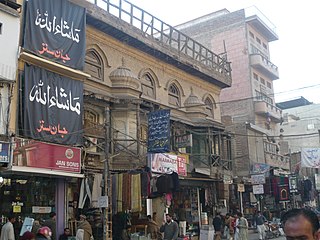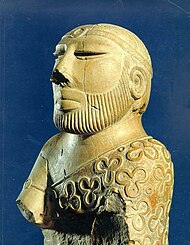
Peshawar is the sixth most populous city of Pakistan, with a district population of over 4.7 million in the 2023 census. It is the capital of the province of Khyber Pakhtunkhwa, where it is the largest city. It is situated in the north-west of the country, lying in the Valley of Peshawar. Peshawar is primarily populated by Pashtuns, who comprise the second-largest ethnic group in the country.

Dera Ismail Khan, abbreviated as D.I. Khan, is a city and capital of Dera Ismail Khan District, located in Khyber Pakhtunkhwa, Pakistan. It is the 37th largest city of Pakistan and fifth largest in the province of Khyber Pakhtunkhwa by population. Dera Ismail Khan is situated on the west bank of the Indus River, at its junction with the Gomal River.
Jamrūd or Jam is a town in the Khyber District of Khyber Pakhtunkhwa, Pakistan. Located in the Valley of Peshawar, on the western fringe of Peshawar city, Jamrud is the doorway to the Khyber Pass which is just to the west of the town. The pass connects Jamrud with Landi Kotal to the west, located near the border of Afghanistan's Nangarhar Province.

Lakki Marwat or Lakki is the headquarters of Lakki Marwat District in Khyber Pakhtunkhwa province of Pakistan. Lakki Marwat has become one of the fastest growing cities in Khyber Pakhtunkhwa. Lakki Marwat is also the 20th most populous city in the province of Khyber Pakhtunkhwa.

The Qissa Khwani massacre in Peshawar, North-West Frontier Province, British India on 23 April 1930 was an armoured vehicle-ramming attack and mass shooting of the unarmed civilian freedom fighters by the British colonial troops, which consequently became one of the defining moments of the independence movement in British India.
The history of Peshawar is intertwined with the history of the broader Indian subcontinent. The region was known as Puruṣapura in Sanskrit, literally meaning "city of men". Being among the most ancient cities of the Indian subcontinent, Peshawar had for centuries been a center of trade between West Asia, Central Asia, and the Indian subcontinent.

Lady Reading Hospital is located at Peshawar in the Khyber Pakhtunkhwa of Pakistan. It is also called Loye Huspatal and Gernali Huspatal. It is named after Lady Reading, the wife of the Viceroy of India, Lord Reading. It is the biggest hospital of Khyber Pakhtunkhwa province, providing tertiary care facilities.
Khyber Mail was a daily newspaper published from Peshawar, Khyber-Pakhtunkhwa, Pakistan. The news service was discontinued in 1989.

The Qissa Khwani Bazaar is a bazaar in Peshawar, the capital of the Khyber Pakhtunkhwa province of Pakistan.

The History of Khyber Pakhtunkhwa refers to the history of the modern-day Pakistani province of Khyber Pakhtunkhwa.
In 2009, Pakistan suffered 50 terrorist, insurgent and sectarian-related incidents that killed 180 people and injured 300.
The following is a timeline of the history of Kabul, Afghanistan.
The following is a timeline of the history of the city of Lahore, Pakistan.
The following is a timeline of the history of the city of Karachi, Pakistan.
On 22 September 2013, a twin suicide bombing took place at All Saints Church in Peshawar, Pakistan, in which 127 people were killed and more than 250 injured. It was the deadliest attack on the Christian minority in the history of Pakistan.
The Qissa Khwani Bazaar bombing took place in the Qissa Khwani Bazaar market in Peshawar, Pakistan on 29 September 2013. A car bomb detonated about 11 a.m. PST in the crowded market, killing 41 people, including 16 relatives, and wounding about 100 more. Two days earlier, a bus bomb in the city killed nineteen government workers.

The Qasim Ali Khan Mosque ; is a 17th-century mosque in Peshawar, Khyber Pakhtunkhwa, Pakistan. Located in Qissa Khwani Bazaar, Mohallah Baqir Shah. The mosque was built during Emperor Aurangzeb's reign, by Qasim Ali Khan, a news writer and administrator in the government of Kabul. The mosque is situated in the Misgaran Qissa Khwani Bazaar.

On 4 March 2022, the Islamic State – Khorasan Province attacked a Shia mosque at Qissa Khwani Bazaar in Peshawar, Khyber Pakhtunkhwa, Pakistan. The suicide attack, carried out by an Afghan man who was a long-term resident of Pakistan, killed at least 63 people and injured another 196. The Islamist terror group Islamic State – Khorasan Province claimed responsibility for the attack.
Peshawar attack may refer to:









